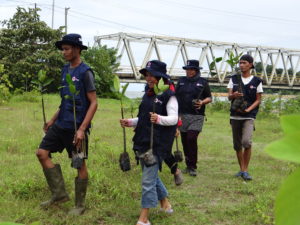This post was written by Jenelle Eli, a member of the American Red Cross international communications team.
 “Just be sure not to wander off the path, okay? We want to avoid alligators.”
“Just be sure not to wander off the path, okay? We want to avoid alligators.”
This phrase reached my ears just moments before following a dozen Red Cross volunteers into waist-deep waters in Aceh, Indonesia. The “path” was an underwater plank leading the way to our mangrove planting spot. The plank was a little wobbly, but one alligator warning was enough to steady my footing.
Ten years ago, this body of water was overwhelmed by the Indian Ocean Tsunami—one of the worst natural disasters in modern history. A massive earthquake set off tsunami waves, which struck coastal communities from Southeast Asia to East Africa. In Indonesia, more than 160,000 people died. Those who survived lost almost everything, including their sources of income, which depended on fishing and other forms of aquaculture from bodies of water like this one.
In the days and years following the tsunami, the American Red Cross helped families rebuild their homes, schools, markets, and communities.
So why, a decade later, are we still in Aceh, Indonesia? And why am I waist-deep in murky water?
After an international disaster – like the Indian Ocean Tsunami – the global Red Cross network can provide immediate necessities like food, water, hygiene kits, and mosquito nets. But people surviving disasters like this tsunami sometimes need way more help than that.
In Indonesia, 500,000 people were left homeless. So over time, the Red Cross built new houses. And then the Red Cross connected those houses to running water. We trained local people to maintain the new sanitation infrastructure so that it continues to deliver safe water for years to come.
But even at that, families who survive major natural disasters might still struggle. In Aceh, people lost their jobs when the tsunami destroyed marketplaces, agricultural land, and the places where they fished. So the Red Cross stayed in Indonesia far past 2004. We rebuilt markets. We supplied spice vendors with equipment. And we are still there, restoring ecosystems by planting mangrove trees.
The new mangrove trees not only slow down storm surges and decrease erosion, they also absorb three times as much carbon dioxide as other trees. They dissolve heavy metals like mercury, so that the fish are safe to eat. The mangrove trees provide a habitat for shrimp and oysters, which deliver a new source of income for local families.
Red Cross volunteers have seen the positive results with their own eyes. That’s why, ten years after the tsunami, they’re wading into murky waters and avoiding alligators… all in the name of planting mangrove trees.
It’s this long-term thinking that ensures people not only get back on their feet after disasters, but that they thrive far into the future.
